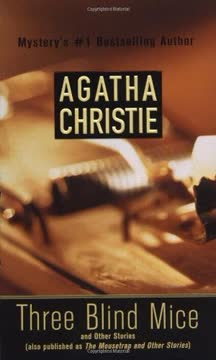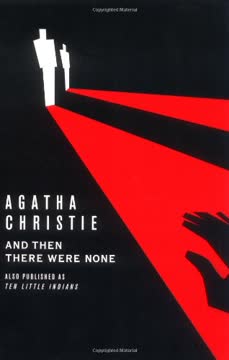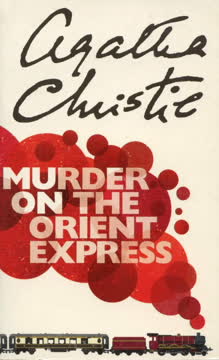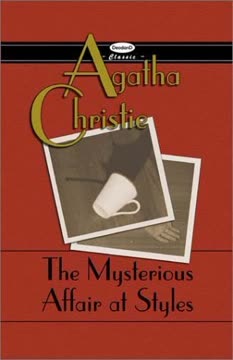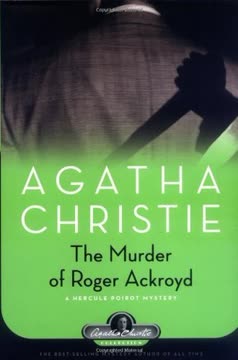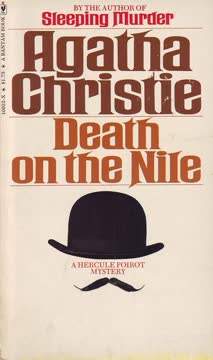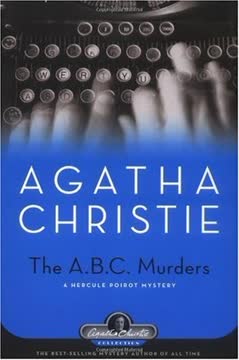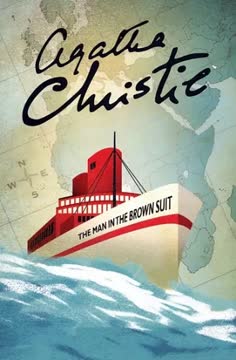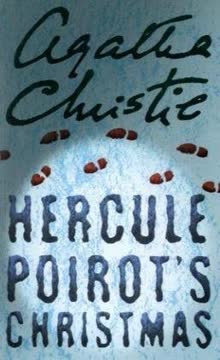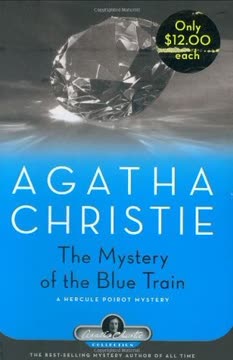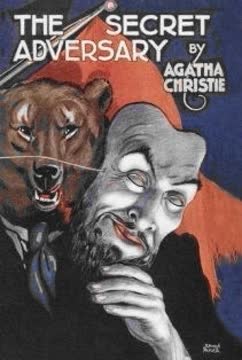Plot Summary
Snowbound at Monkswell Manor
Molly and Giles Davis, newlyweds, inherit Monkswell Manor and decide to turn it into a guesthouse. As a heavy snowstorm isolates the house, a motley group of guests arrives: the eccentric Christopher Wren, the formidable Mrs. Boyle, the reserved Major Metcalf, and the mysterious Mr. Paravicini, who claims to have crashed his car in the snow. The couple's inexperience is evident, but the mood is one of excitement and anticipation—until the radio reports a murder in London, and the snow cuts them off from the outside world.
Nursery Rhyme Murders
The guests settle in, but tension rises as news spreads of a murder in London, linked to the nursery rhyme motif "Three Blind Mice." The killer left a note and a drawing of three mice, suggesting more murders to come. The guests, each with their own quirks and secrets, begin to eye each other with suspicion. The snowstorm ensures no one can leave or enter, trapping everyone in a classic closed circle mystery.
Guests with Secrets
As the snow deepens, the guests' backgrounds come under scrutiny. Mrs. Boyle is revealed to have been a billeting officer during the war, responsible for sending children to foster homes. Christopher Wren's odd behavior and nervousness make him a suspect. Major Metcalf is reticent about his past, and Mr. Paravicini's sudden appearance and theatrical mannerisms arouse suspicion. Even Molly and Giles begin to doubt each other, as small clues suggest hidden connections to the past.
The Arrival of Trotter
Detective Sergeant Trotter arrives on skis, sent by the police to warn the household: the London murder is connected to Monkswell Manor. He reveals the backstory of the Longridge Farm case, where three foster children were abused, one dying as a result. The killer, it seems, is seeking revenge on those connected to the tragedy. Trotter insists that someone in the house is in grave danger, and that the murderer may already be among them.
The Three Blind Mice Trap
Despite Trotter's efforts, Mrs. Boyle is found murdered, strangled while alone in the library. Panic and paranoia grip the house. Trotter interrogates everyone, reconstructs their movements, and tries to identify the killer. The guests' alibis are shaky, and the atmosphere is thick with mistrust. The "Three Blind Mice" motif haunts the proceedings, as it becomes clear the killer is following a plan.
The Unmasking
Trotter orchestrates a reenactment of the murder, hoping to catch the killer in a lie. In a tense showdown, it's revealed that Trotter is not a real policeman but the vengeful brother of the abused child from Longridge Farm. He attempts to kill Molly, whom he believes is complicit, but is stopped at the last moment by Major Metcalf—who is, in fact, an undercover police inspector. The real connections between the guests and the past are clarified, and the threat is ended.
Inheritance and Hidden Clues
In "Strange Jest," two young heirs, Charmian and Edward, seek their late uncle's hidden fortune. With Miss Marple's help, they decipher a series of playful clues—puns, recipes, and fake love letters—leading to rare stamps hidden in old envelopes. The story highlights Christie's love of wordplay and the gentle unraveling of family secrets.
The Dressmaker's Deception
In "Tape Measure Murder," Miss Marple investigates the strangling of Mrs. Spenlow, a well-to-do woman in St. Mary Mead. The local dressmaker, Miss Politt, is revealed to be the killer, motivated by a decades-old jewel robbery she committed with the victim. Marple's attention to small details—like a special pin—cracks the case, restoring justice and clearing the innocent.
The Perfect Maid's Disguise
In "The Case of the Perfect Maid," the Skinners, two sisters, hire a seemingly perfect maid after dismissing their previous one under suspicion of theft. When the new maid absconds with valuables from several tenants, Miss Marple deduces that she was actually one of the sisters in disguise, running a clever theft operation. The story explores themes of trust, appearances, and the dangers of perfection.
The Caretaker's Secret
In "The Case of the Caretaker," Miss Marple, recovering from illness, is given a puzzle by her doctor. A young bride dies in a riding accident, seemingly cursed by a displaced caretaker. Marple deduces that the husband orchestrated the accident and used the caretaker's supposed curse as a cover for murder, motivated by money and a new love interest. The story is a meditation on appearances and the darkness beneath domestic bliss.
The Fatal Third Floor
In "The Third Floor Flat," a group of young people accidentally discover a woman's body in the flat below. Hercule Poirot, living upstairs, is drawn into the case. Through careful observation, he uncovers that one of the group, Donovan, is a bigamist who murdered his secret wife to marry another. Poirot's attention to the details of the crime scene and the psychology of the suspects leads to the truth.
The Kidnapped Heir
In "The Adventure of Johnnie Waverly," the young son of a wealthy couple is kidnapped despite police protection. Poirot investigates and discovers that the father staged the kidnapping to extort money from his wife and cover his own financial misdeeds. Poirot's methodical approach and understanding of human nature expose the plot and reunite the family.
Blackbirds and Alibis
In "Four and Twenty Blackbirds," Poirot investigates the death of an eccentric old man who dined at the same restaurant every week. When the man is found dead, Poirot notices that his last meal was out of character. He deduces that the man's nephew impersonated him to create an alibi and murdered him for an inheritance. Poirot's insight into habits and psychology cracks the case.
Lovers and Lies
In "The Love Detectives," a country squire is found murdered, and both his wife and her lover confess to the crime. Mr. Satterthwaite and Mr. Quin unravel the truth: the confessions are false, meant to protect each other, and the real killer is the valet, motivated by dismissal and desperation. The story explores the interplay of love, sacrifice, and justice.
Confessions and Red Herrings
Throughout the collection, Christie plays with the idea of confession—characters often admit to crimes they did not commit, either out of love, guilt, or a desire to protect others. These red herrings challenge both the detectives and the reader, emphasizing the complexity of motive and the unreliability of appearances.
Justice and Restoration
In each story, the detective—whether Poirot, Marple, or another—restores order and justice, but not without cost. The psychological wounds, betrayals, and secrets exposed leave lasting marks on the survivors. Christie's stories end with the truth revealed, but the emotional consequences linger, reminding readers that justice is not always simple or painless.
Characters
Molly Davis
Molly is the young co-owner of Monkswell Manor, eager to make her guesthouse a success. She is practical and kind, but as the murders unfold, she becomes a target of suspicion and psychological manipulation. Her relationship with Giles is tested by mistrust and fear, but her resilience and honesty ultimately help her survive the ordeal.
Giles Davis
Giles is Molly's husband, a former naval officer. He is handy and determined, but his secretive nature and unexplained trips make him a suspect in the eyes of others—and even Molly. His jealousy and protectiveness are both strengths and weaknesses, and his character arc is one of learning to trust and communicate.
Christopher Wren
Christopher is a young, nervous guest with a flamboyant personality and a troubled past. His odd behavior and resemblance to the suspected killer's profile make him a prime suspect. However, his vulnerability and honesty reveal him to be more a victim of circumstance than a villain, highlighting themes of prejudice and misunderstanding.
Mrs. Boyle
A former billeting officer, Mrs. Boyle is domineering and critical, quick to find fault in others. Her past connection to the Longridge Farm case makes her a target, and her inability to empathize or adapt ultimately leads to her murder. She represents the dangers of rigid authority and lack of self-awareness.
Major Metcalf / Inspector Tanner
Initially presented as a reserved ex-military man, Metcalf is later revealed to be Inspector Tanner, working undercover to protect the guests and unmask the killer. His calm demeanor and methodical approach contrast with the hysteria around him, and his intervention is crucial in the story's climax.
Mr. Paravicini
Paravicini is an enigmatic guest whose sudden arrival and odd behavior make him a perpetual suspect. His foreignness and penchant for mischief add to the atmosphere of uncertainty. Ultimately, he is a red herring—his secrets are criminal but unrelated to the murders, serving as a commentary on xenophobia and misdirection.
Detective Sergeant Trotter / Jim
Trotter arrives as a police sergeant but is revealed to be Jim, the vengeful brother of the abused child from the Longridge Farm case. His psychological scars and obsession with justice drive him to murder, and his ability to manipulate appearances and authority is both chilling and tragic.
Miss Marple
Appearing in several stories, Miss Marple is the archetypal amateur sleuth. Her deep understanding of human nature, attention to detail, and unassuming manner allow her to see through lies and solve crimes that baffle others. She represents the power of observation and empathy.
Hercule Poirot
Poirot, Christie's iconic detective, appears in several stories, using his "little grey cells" to unravel complex mysteries. His psychological insight, attention to routine, and understanding of motive make him a formidable investigator. He often exposes the hidden emotional currents beneath seemingly straightforward crimes.
Mr. Satterthwaite and Mr. Quin
Satterthwaite is a genteel observer of life, while Mr. Quin is a mysterious, almost supernatural figure who prompts revelations and resolutions. Together, they explore the interplay of love, guilt, and fate, often uncovering truths that elude conventional detectives.
Plot Devices
Closed Circle Mystery
The snowbound setting of Monkswell Manor creates a classic "locked room" scenario, where the killer must be among the guests. This device heightens tension, forces characters to confront each other, and allows Christie to explore the psychology of suspicion and paranoia.
Nursery Rhyme Motif
The "Three Blind Mice" rhyme is used as a chilling signature for the murders, contrasting the innocence of childhood with the brutality of revenge. This motif recurs throughout the story, serving as both a clue and a psychological weapon.
Red Herrings and False Confessions
Christie employs numerous red herrings—suspicious behavior, hidden pasts, and false confessions—to mislead both characters and readers. These devices challenge assumptions and force a deeper examination of motive and character.
Psychological Trauma and Revenge
The central crime is rooted in the trauma of childhood abuse and the desire for retribution. The killer's psychological scars are mirrored in the suspicions and fears of the other characters, creating a web of emotional complexity.
Hidden Clues and Wordplay
In stories like "Strange Jest," Christie uses puns, recipes, and coded messages as clues, inviting readers to solve the mystery alongside the characters. This device emphasizes the intellectual pleasure of detection.
Undercover Identities
Several characters are not who they seem—Trotter is a killer, Metcalf is a detective, the perfect maid is a thief in disguise. These hidden identities drive the plots and underscore the theme that truth is often masked by appearances.
Analysis
"Three Blind Mice and Other Stories" is a masterclass in the art of the short mystery, showcasing Agatha Christie's unparalleled ability to blend psychological insight, intricate plotting, and social observation. The collection's central novella, "Three Blind Mice," distills the essence of the classic whodunit: a group of strangers, each with secrets, trapped by circumstance, and stalked by a killer whose motives are rooted in past trauma and injustice. Christie's use of nursery rhymes, red herrings, and closed-circle settings creates an atmosphere of mounting dread and suspicion, while her recurring detectives—Poirot, Marple, and others—demonstrate the power of observation, empathy, and logic to restore order. The stories probe the darkness beneath everyday life, exposing how guilt, love, greed, and revenge can drive ordinary people to extraordinary acts. Ultimately, Christie's work endures because it is as much about the frailty and resilience of the human psyche as it is about the mechanics of crime. The lessons are clear: appearances deceive, justice is complex, and the past is never truly buried.
Last updated:
FAQ
Synopsis & Basic Details
What is Three Blind Mice and Other Stories about?
- A Collection of Mysteries: This anthology features nine short stories and a novella, "Three Blind Mice" (later adapted as The Mousetrap), showcasing Agatha Christie's diverse range of detective fiction. The narratives span various settings, from a snowbound guesthouse to a quiet English village and bustling London flats, each presenting a unique puzzle for her iconic detectives.
- Unraveling Human Nature: At its core, the collection delves into the complexities of human motivation, exploring themes of revenge, greed, love, and deception. Readers are invited to observe how seemingly ordinary individuals are driven to extraordinary acts, often with hidden pasts and carefully constructed facades.
- Classic Detective Work: The stories feature beloved characters like Hercule Poirot, Miss Marple, and the enigmatic Mr. Harley Quin, who employ their distinct methods—from Poirot's "little grey cells" and meticulous logic to Marple's village-gained insights into human nature—to expose the truth behind murders, kidnappings, and elaborate deceptions.
Why should I read Three Blind Mice and Other Stories?
- Masterclass in Suspense: Christie expertly crafts an atmosphere of tension and psychological intrigue, particularly in "Three Blind Mice," where a group of strangers is isolated with a vengeful killer. The collection offers a thrilling journey through various forms of crime, keeping readers guessing until the very last page.
- Diverse Detective Styles: Experience the unique approaches of Christie's most famous sleuths. Poirot's analytical brilliance, Marple's astute observations of village life, and Mr. Quin's catalytic insights provide a rich tapestry of investigative methods, making each story a fresh intellectual challenge.
- Subtle Clues and Twists: Beyond the surface plot, Christie embeds clever foreshadowing, symbolic details, and unexpected reversals that reward close reading. The stories are not just about who did it, but how and why, often revealing deeper truths about society and individual psychology.
What is the background of Three Blind Mice and Other Stories?
- Post-War Context: Many stories reflect the social and economic landscape of post-World War II Britain, with references to rationing, housing shortages, and the lingering psychological effects of conflict. "Three Blind Mice" itself, originally a radio play, captures the anxieties of a nation rebuilding, where past traumas can resurface with deadly consequences.
- Evolution of a Classic: The titular novella, "Three Blind Mice," was first a radio play commissioned for Queen Mary's 80th birthday in 1947, then a short story, and finally adapted into the world-famous stage play The Mousetrap. This evolution highlights Christie's adaptability and the enduring appeal of its core premise.
- Christie's Signature Themes: The collection showcases Christie's recurring fascination with hidden identities, the unreliability of appearances, and the idea that evil can lurk beneath the most respectable exteriors. It also demonstrates her mastery of the "closed circle" mystery, where a limited cast of suspects intensifies the psychological drama.
What are the most memorable quotes in Three Blind Mice and Other Stories?
- "Three Blind Mice, See how they run...": This chilling nursery rhyme, central to the novella, becomes a haunting motif for revenge and psychological trauma. It transforms an innocent childhood tune into a sinister countdown, underscoring the killer's disturbed mind and the dark origins of the plot.
- "The murderer's enjoying himself. That's the one thing I'm quite sure of.": Sergeant Trotter's (Jim's) chilling observation in "Three Blind Mice" reveals the psychological depth of the killer, highlighting the sadistic pleasure derived from the meticulously planned revenge. This quote foreshadows his own identity and the twisted satisfaction he takes in his actions.
- "I don't believe in paragons. Most of us have our faults—and domestic service shows them up very quickly!": Miss Marple's astute remark in "The Case of the Perfect Maid" encapsulates her deep understanding of human nature and her skepticism towards outward perfection. It's a defining statement of her philosophy, revealing her ability to see through facades to the underlying truth.
What writing style, narrative choices, and literary techniques does Agatha Christie use?
- Deceptive Simplicity: Christie employs a clear, concise, and seemingly straightforward prose style that belies the intricate complexity of her plots. This directness allows readers to focus on the puzzle, while subtle details and character observations are woven in without drawing undue attention.
- Master of Misdirection: Her narrative choices frequently involve unreliable narrators, red herrings, and carefully constructed alibis designed to mislead the reader. She often presents multiple plausible suspects, each with a motive and opportunity, before revealing an unexpected truth, as seen in the false confessions in "The Love Detectives."
- Psychological Realism & Social Commentary: Beyond the mechanics of crime, Christie uses literary techniques like internal monologue and dialogue subtext to explore the psychological states of her characters—their fears, anxieties, and hidden desires. She also subtly critiques social norms, class distinctions, and the dangers of prejudice, particularly evident in the character of Mrs. Boyle in "Three Blind Mice."
Hidden Details & Subtle Connections
What are some minor details that add significant meaning?
- Molly's "Unreal" Feeling: Early in "Three Blind Mice," Molly reflects, "Her whole life, at the moment, seemed unreal—Giles seemed unreal. She was playing a part—just playing a part." This seemingly throwaway line subtly foreshadows not only her own hidden past and the role she's playing as a guesthouse owner but also the profound deception within her marriage and the true identities of several guests, including Giles.
- Paravicini's Makeup and Youthful Gait: Mr. Paravicini's "cleverly but decidedly 'made up'" face and "youthful jauntiness of his step" are noted by Molly. This detail, initially dismissed as an old man's vanity, hints at a deliberate disguise, suggesting he is not only younger than he appears but also a master of deception, aligning with his later reveal as a black marketeer who "comes in on tiptoe" and "overhears things."
- The "Special Pin" in "Tape Measure Murder": Constable Palk picks up a "common pin" near Mrs. Spenlow's body, but Miss Marple immediately identifies it as a "special pin, a very thin pin, the kind you buy by the box, the kind used mostly by dressmakers." This minute detail is the linchpin of the entire case, proving Miss Politt was already inside the house and had staged her arrival, demonstrating Marple's unparalleled attention to seemingly insignificant objects.
What are some subtle foreshadowing and callbacks?
- Christopher Wren's "Signature Tune": In "Three Blind Mice," Christopher Wren whistles "Three Blind Mice" and calls it his "signature tune" early on, even joking about being taken for a murderer. This playful, yet unsettling, detail directly foreshadows the killer's use of the nursery rhyme as a motif and ironically points to Christopher as a prime suspect, even though he is ultimately innocent of the murders.
- Poirot's "Bad Fish" Metaphor: In "Four and Twenty Blackbirds," Poirot's friend Bonnington complains about "too much fine language" concealing "mess," like "highly-flavoured sauce concealing the fact that the fish underneath it is none of the best!" Poirot later echoes this, saying, "The trouble is, there is too much sauce over the bad fish." This metaphor subtly foreshadows the elaborate alibi and false evidence (the "sauce") designed to cover up the "bad fish" of murder, which Poirot sees through by focusing on the underlying facts.
- The Maid's Defense of Jennings: In "The Love Detectives," the scared maid Jane defends Jennings, saying, "Oh! Indeed, sir, he wouldn't hurt a fly." This seemingly loyal defense, dismissed by Mr. Satterthwaite at the time, is a crucial callback to the idea that those closest to the truth often have a vested interest in protecting the guilty, or in this case, the wrongly accused, subtly pointing away from Jennings as the killer.
What are some unexpected character connections?
- Molly's Unacknowledged Past: In "Three Blind Mice," Molly's maiden name, Wainwright, and her past as a schoolteacher at Abbeyvale school are revealed, connecting her directly to the Longridge Farm case. This connection is unexpected because she initially denies any knowledge, highlighting her deep-seated trauma and desire to suppress a painful past, making her a potential third victim.
- The Skinners' Dual Identity: In "The Case of the Perfect Maid," the revelation that "Miss Emily" and "Mary Higgins" are the same person is a brilliant twist. The seemingly frail, hypochondriac Miss Emily is, in fact, the robust and cunning "perfect maid" Mary, allowing the sisters to orchestrate thefts while maintaining an impeccable reputation. This connection subverts expectations about age, infirmity, and social roles.
- Harry Laxton's Consistent Type: In "The Case of the Caretaker," Miss Marple observes, "gentlemen always tend to admire the same type." This seemingly general comment connects Harry Laxton's past "old flame," Bella Edge (dark, vivacious), with his current attraction to Clarice Vane (tall, dark, handsome). This pattern reveals his true preferences and, by contrast, highlights his marriage to the "fair-haired and clinging" Louise as one of convenience, driven by money, thus establishing a motive for murder.
Who are the most significant supporting characters?
- Mrs. Casey (Three Blind Mice): The landlady of Mrs. Lyon, her brief appearance and "funny feeling" about the killer, combined with her inability to provide a clear description, establish the elusive nature of the murderer and the initial ambiguity of the case. She sets the stage for the "everyman" description of the killer, making everyone a suspect.
- Edna (The Case of the Perfect Maid): Miss Marple's "little maid" serves as the initial catalyst for the investigation into Gladys's dismissal. Her loyalty to her cousin and her distress over the injustice provide Miss Marple with the emotional impetus to delve into the Skinner sisters' affairs, highlighting the importance of protecting the innocent and upholding justice for the working class.
- Molly, the Waitress (Four and Twenty Blackbirds): Molly's keen observation of "Old Father Time's" unusual dinner order is the crucial detail that sparks Poirot's investigation. Her memory of a regular customer's habits, contrasted with the doctor's focus on official timelines, underscores Christie's theme that everyday observations can often reveal more than professional scrutiny.
Psychological, Emotional, & Relational Analysis
What are some unspoken motivations of the characters?
- Giles's Jealousy and Deception: In "Three Blind Mice," Giles's "insanely jealous" reaction to Molly's perceived connection with Christopher Wren, coupled with his own secret trip to London for an anniversary present, reveals a deep-seated insecurity and a need to control. His unspoken fear of losing Molly, and his own hidden past, drive his aggressive behavior and contribute to the atmosphere of mistrust.
- Miss Politt's Resentment and Greed: In "Tape Measure Murder," Miss Politt's "excessively thin and genteel" voice and her past as a "lady's maid" mask a profound resentment and a long-held criminal secret. Her motivation to murder Mrs. Spenlow is not just about preventing exposure of the old jewel robbery, but also a deep-seated bitterness over her own "unlucky" life as a "village dressmaker" compared to Mrs. Spenlow's continued prosperity.
- Mr. Waverly's Financial Desperation: In "The Adventure of Johnnie Waverly," Mr. Waverly's "jovial-looking" exterior hides a desperate financial situation and a willingness to exploit his own family. His motivation for staging his son's kidnapping is to extort money from his wealthy wife, revealing a calculated ruthlessness beneath his country squire facade, driven by a desire to maintain his lifestyle without dipping into his wife's fortune.
What psychological complexities do the characters exhibit?
- Jim's Regression to Childhood Trauma: In "Three Blind Mice," Sergeant Trotter's true identity as Jim, the traumatized brother, reveals a profound psychological regression. His "child's smile" and voice, coupled with his obsession with the nursery rhyme, illustrate how deep-seated childhood abuse has warped his perception of justice and driven him to a chilling, almost ritualistic, revenge.
- Miss Emily Skinner's Calculated Hypochondria: In "The Case of the Perfect Maid," Miss Emily's "indecisive-looking creature" persona and her constant complaints are a meticulously crafted psychological facade. Her hypochondria is not merely an illness but a strategic tool to avoid suspicion, manipulate her sister, and provide an alibi for her criminal activities as "Mary Higgins," showcasing a cunning mind beneath a veneer of frailty.
- Laura Dwighton's Dramatic Self-Sacrifice: In "The Love Detectives," Laura Dwighton's "pure Renaissance type" beauty and her dramatic confession to murder ("I killed him!") are rooted in a complex mix of love, guilt, and a theatrical nature. Her willingness to sacrifice herself for Paul Delangua, even when she didn't commit the crime, highlights the powerful, sometimes irrational, emotional forces that drive human behavior in the face of tragedy.
What are the major emotional turning points?
- Molly's Realization of Giles's Deception: In "Three Blind Mice," Molly's dawning horror upon seeing the two-day-old Evening Standard and realizing Giles was in London, not "over at Sailham," marks a critical emotional turning point. This moment shatters her trust and forces her to confront the terrifying possibility that her husband, whom she "loved at first sight," is a liar, and potentially the killer, plunging her into profound fear and isolation.
- Miss Marple's Indignation for Gladys: In "The Case of the Perfect Maid," Miss Marple's initial "no particular liking for the bouncing, self-opinionated Gladys" transforms into fierce indignation when Gladys's honesty is questioned. Her declaration, "I'm not going to have one of our village girls' character for honesty taken away like that!" is a powerful emotional turning point, motivating her to actively investigate and expose the Skinners' deception.
- Doctor Haydock's Discovery of the Syringe: In "The Case of the Caretaker," Doctor Haydock's initial sympathy for the "bereaved husband" Harry Laxton turns to suspicion when a hypodermic syringe "fell out of his pocket." This unexpected detail, coupled with Harry's "scared" reaction, is the emotional and intellectual turning point that leads the doctor to conduct a targeted autopsy and uncover the truth of the murder.
How do relationship dynamics evolve?
- Molly and Giles's Fractured Trust: The initial "whirlwind courtship" and "miracle of each other" between Molly and Giles in "Three Blind Mice" rapidly devolves into suspicion and accusation under pressure. Their relationship is tested by hidden pasts and mutual deception, evolving from naive newlywed bliss to a fragile, almost broken state, only to be tentatively restored by the end, scarred but with a new foundation of honesty.
- The Shifting Alliances in Monkswell Manor: As Sergeant Trotter (Jim) reveals the connection to the Longridge Farm case, the relationships among the guests in "Three Blind Mice" shift dramatically. Initial polite interactions give way to open suspicion, fear, and accusations, particularly against Christopher Wren. This dynamic highlights how external threats can expose underlying prejudices and force characters to reveal their true natures or hidden connections.
- The Symbiotic Partnership of Satterthwaite and Quin: In "The Love Detectives," the friendship between the "town bird" Mr. Satterthwaite and the "simple country gentleman" Colonel Melrose is contrasted with Satterthwaite's unique bond with Mr. Harley Quin
Review Summary
Three Blind Mice and Other Stories is a collection of short mysteries featuring Christie's famous detectives Poirot and Miss Marple. Readers praise the title story, which became the play "The Mousetrap," for its suspense and twists. The other stories receive mixed reviews, with some finding them entertaining and others feeling they lack depth due to their brevity. Fans appreciate Christie's clever plotting and character psychology, though some note the collection is not her strongest work overall.
Download PDF
Download EPUB
.epub digital book format is ideal for reading ebooks on phones, tablets, and e-readers.
